
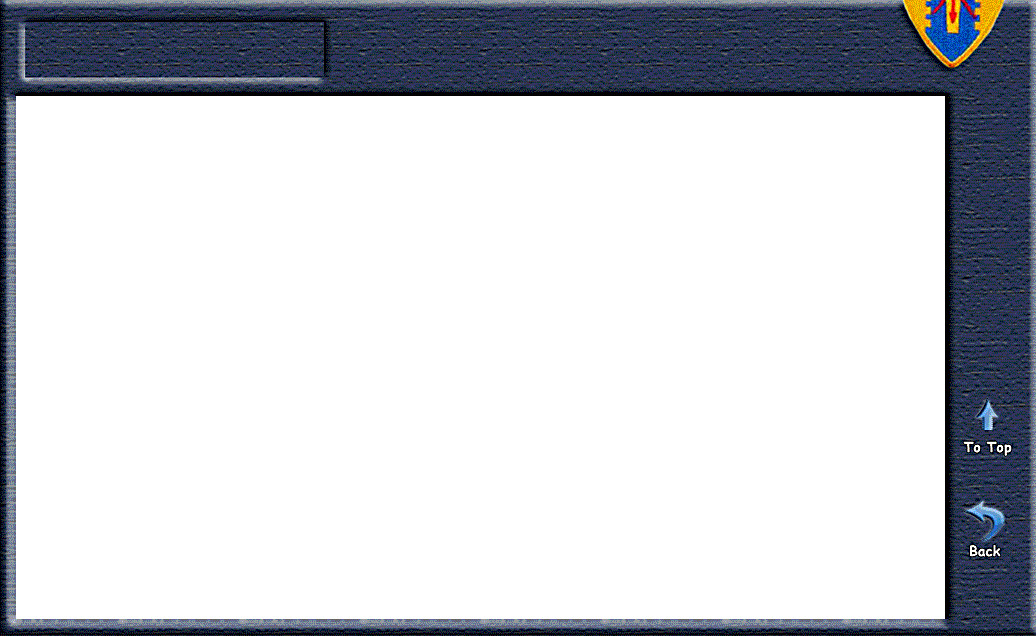
by Ken Mick
This is a composite of several incidents to present a realistic story of how the Hunter-Killer Team operated in combat. See the story Slingload to find out what happened to Ken's shot up Cobra.
.....................................................................................................................................................................................
 With my copilot B.J, I strolled out to the flight line at Tan My. Reaching our aircraft, I was struck by how different this flight would be. B.J. called to me from the back seat. I climbed into the troop compartment of a UH-1 Huey helicopter.
With my copilot B.J, I strolled out to the flight line at Tan My. Reaching our aircraft, I was struck by how different this flight would be. B.J. called to me from the back seat. I climbed into the troop compartment of a UH-1 Huey helicopter.
As a passenger, I felt no stress. I would fire no rockets, watch no Loach search for enemy troops, nor direct any airstrikes. Today I would devote my energy to watching the lush terrain unroll beneath our low-flying aircraft.
I buckled my seat belt and plugged my helmet into the commo system, reporting readiness and awaiting the finish of pre-flight checks by Centaur 22, CW2 Avery and his copilot. His crew chief, SGT Holt called “Clear right.” Riding on the left side, B.J. called “Clear left.”
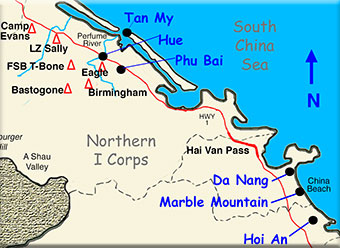
“Tan My tower, Centaur 22 ready for departure. Five on board, enroute Marble Mountain.” “Centaur 22, no reported traffic. Cleared to hover/taxi runway 09. Depart when ready. Report clear of Phu Bai.” CW2 Avery lifted to a hover and moved the Huey to runway 09 and transitioned smoothly into his takeoff procedure. Passing the runway apron, he turned south and settled into a 90-knot cruise at 50-foot altitude for the trip south along the beach. Local villagers waved as we passed and children raced along the sand. The only anticipated danger on this route was the occasional net for a fish trap, raised on posts 10-feet above the water, drying in the heat.
B.J. and I were getting a day off from flying combat missions. Headed to Marble Mountain, the former USMC airfield south of Danang, we could relax and enjoy the vista. Our only responsibility commenced when we landed and reported to F Troop maintenance to pick up our brand new AH-1G Cobra, a 1970 model with less than 50 flight hours recorded in its pristine log book. It was as close to new as you could get. Its problems, if any, would be discovered by me. It would have no bullet holes covered with 100 mile-an-hour tape and the paint would all be factory-fresh and of a uniform shade.
Exiting the beach, the Huey flew west to intercept QL1, the main highway, below Phu Bai. We flew IFR (commonly known in Vietnam as I Follow Roads), as we continued south, verdant fields pocked by the grey shapes of ancient French blockhouses emerged. The ugly structures now housed ARVN outposts and ghostly whispers of skirmishes past.
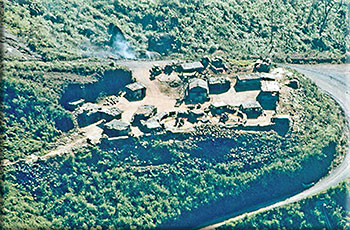 Ahead, the road rose as it climbed toward the 1600-foot elevation of the Hai Van Pass. The highway continued south, threading a course between green mountains on the right and the azure expanse of the South China Sea on the left.
Ahead, the road rose as it climbed toward the 1600-foot elevation of the Hai Van Pass. The highway continued south, threading a course between green mountains on the right and the azure expanse of the South China Sea on the left.
At the summit, a pair of concrete forts appeared, manned by small units of ARVN soldiers. Children, wives and farm animals circulated within the enclosures, waving and clapping as we passed low overhead.
On the south side of the crest, the road fell away steeply toward another world with the modern city of Danang in the far distance. As the terrain leveled, we returned to the beach. Spectacular views continued to emerge.
Near Danang Air Force Base, Centaur 22 called. “Danang Tower, Centaur 22, single UH-1 transiting beach route, destination Marble Mountain.” “Centaur aircraft, Danang tower. You are cleared beach route southbound. Remain below 100-feet. Fast movers on approach to runway 27. Call clear south and contact Marble Mountain tower on published frequency.”
 Acknowledging tower, we continued south at a 50-foot altitude. The approach end of runway 27 came into view at two-o’clock, simultaneously displaying the twin exhausts of an Air Force F-4 Phantom fighter jet passing close above our craft with gear lowered and visible vortices of mist streaming from each wing tip. The Huey rocked violently as we transited the turbulent airflow.
Acknowledging tower, we continued south at a 50-foot altitude. The approach end of runway 27 came into view at two-o’clock, simultaneously displaying the twin exhausts of an Air Force F-4 Phantom fighter jet passing close above our craft with gear lowered and visible vortices of mist streaming from each wing tip. The Huey rocked violently as we transited the turbulent airflow.
Overflying the glorious expanse of China Beach, CW2 Avery called Marble Mountain and received clearance for a straight-in approach to the maintenance helipad.
“Centaur maintenance, Centaur 22 approaching helipad. Ground guide in sight.” “22, maintenance. Truck on way to pick up your cargo and passengers.”
After a flight of 100km, we landed in a peaceful environment. Not once had we been fired upon during our flight. Life looked different from this side of the looking glass.
Upon our return to Tan My, parked on the ramp, the new helicopter looked as though it had just emerged from the showroom floor onto the parking lot. The freshly-painted sharks’ teeth and the Centaur insignia on the doghouse alongside the main rotor mast provided the menacing appearance befitting a killing machine.
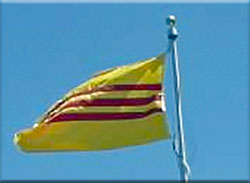 The flight back north on QL1 had been a joy and proved incident free. Passing over the Hai Van Pass with its prominent yellow and red-striped RVN flag, its waving excited children and peaceful soldiers gave lie to the war progressing a few miles away.
The flight back north on QL1 had been a joy and proved incident free. Passing over the Hai Van Pass with its prominent yellow and red-striped RVN flag, its waving excited children and peaceful soldiers gave lie to the war progressing a few miles away.
“Tan My tower, Centaur 49 abeam Phu Bai. Request landing.”
“Centaur 49, Tan My. You are cleared on beach route, landing runway 27. Call final.”
Sergeant Max, the gun platoon NCO met us at our parking spot along with Specialist Smith, my crew chief. Both were eager to check out the new ship. As I climbed out of my compartment, I held aloft a small green cardboard pine-scented car freshener, given to me by the maintenance sergeant at Marble Mountain. It had hung from the gun sight on our northern flight and imparted a bit of stateside aroma to the occasion. Smiles and thumbs-up greeted the memento.
I signed off the log entries and noted no deficiencies, an unusual entry. I passed the book to Specialist Smith, who began his daily inspection. Max waited to take us to Operations for a debrief.
CPT Graph, the operations officer, met our arriving jeep. “Glad to see you back. Are you up?” “Aircraft is being fueled. Armed and ready, Sir.” “OK. You’re team lead on tomorrow’s mid-morning mission. I’ll have details for you at 1900. I’m giving you a routine VR for your new Cobra’s first mission.”
Our flight consisted of two OH-6 Loaches, Centaurs 21 and 26; two AH-1Cobras, 49 and 45 and a UH-1Huey, Centaur 32. The team’s first task would be a Bomb Damage Assessment, (BDA) for a B-52 Arc Light bombing of the area between FSB Bastogne and the A Shau Valley. We would orbit between FSB Birmingham and FSB Bastogne. The mission would be accomplished by a flight of three B-52s flying above effective missile altitude with contrails barely visible from ground level. The lead aircraft would drop its bombs in a line, followed by the second and third planes. When all bombs had impacted the target area, our two loaches would overfly the bomb site and report on its effectiveness. Our Cobras would protect the scouts and engage any bad guys.
I awaited the bomber contact with excitement. Seeing the awesome destructive power of the B-52 trio provided a singular visual and auditory event.
“Centaur 49, Bombard, two mikes out. Will call drop.”
We continued to orbit, then “Centaur, Bombard, drop.” Our flight view remained riveted on the jungle target to the west.
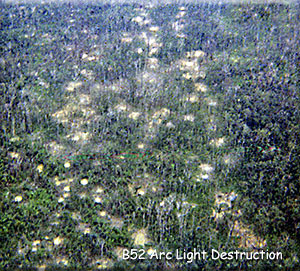 “Massive explosions erupted across the designated area, marching south in a continuous ripple of mayhem. Trees, earth and fortifications rocketed hundreds of feet into the air. Sound followed sight and rumbled past us. I imagined a breaking wave lifting our flight’s boats as it headed east. A second load of bombs and a third impacted. The western area had become a solid wall rising out of the verdant hell.
“Massive explosions erupted across the designated area, marching south in a continuous ripple of mayhem. Trees, earth and fortifications rocketed hundreds of feet into the air. Sound followed sight and rumbled past us. I imagined a breaking wave lifting our flight’s boats as it headed east. A second load of bombs and a third impacted. The western area had become a solid wall rising out of the verdant hell.
“Centaur flight, Bombard clear. It’s all yours now.” “Bombard, Centaur 49. Roger. Will pass results when able.”
“Centaur flight, 21 & 26 cleared in. Work north to south, one pass only.” “49, 21 roger. North to south, one pass.”
The two Loaches sprinted ahead. Centaur 21, the leader, called “Numerous old bunkers. No visible troops.” Centaur 26 followed, searching and ready to support 21. Nearing halfway down the churned strike area the Loaches still had no contact.
“49, 21 now seeing soldiers. So far they are dazed and confused. Bunkers now recent.”
My Cobra fire-team remained outside the bombed area, keeping the Loaches in sight. BDA often produced nothing except hundreds of feet of destroyed vegetation. However, the situation could quickly escalate. Dazed and confused enemy troops rapidly awakened.
“21 taking fire.” The loach began to evade in a zig-zag pattern. Centaur 26, his wingman poured mini-gun fire in 21’s wake. “21 & 26, 49 inbound.”
The loaches fled to the southeast and I began to rain 40mm grenades and mini-gun fire onto the smoke rising from a marker dropped by the scouts. Like ants emerging from a broken hive, the NVA troops swarmed. My gunfire mowed them down in waves. Centaur 45 followed me with rockets as I broke east. I continued around to make another pass.
Whang! A sledge hammer noise shook the aircraft. I quickly turned away and scanned the instrument panel for flashing warnings. No indicators caught my eye. “Centaur 49, 45. Guess you broke your cherry.” I was furious at the damage to my new aircraft. “The maintenance officer is going to be pissed,” I said to BJ.
“Maybe he won’t notice,” he said. “Right, a new hole in the pristine paint of the only new aircraft in the unit.”
 As though he could hear us, Centaur Ops called. “49, Centaur 3. Do you have enough fuel and ammo for a quick VR on your way home?” “3, this is 49. We can cover a quick look as long as it’s not further west.” “49, 3. Contact FSB Birmingham on the Fox Mike push. He wants you to check out the area where the M-41 tank was destroyed near Bastogne. Covey FAC on call if you find anything.”
As though he could hear us, Centaur Ops called. “49, Centaur 3. Do you have enough fuel and ammo for a quick VR on your way home?” “3, this is 49. We can cover a quick look as long as it’s not further west.” “49, 3. Contact FSB Birmingham on the Fox Mike push. He wants you to check out the area where the M-41 tank was destroyed near Bastogne. Covey FAC on call if you find anything.”
“Centaur flight, 49. We’ve been tasked with a quick recon of the area near the road southeast of Bastogne. Looking for sign of other captured tanks or tracked vehicles. Covey FAC on call. Check in with fuel and ammo. Anyone with a problem?” When all aircraft reported their ready status, we proceeded east, staying south of the regional route. South of FSB Bastogne, the loaches sprang ahead.
“49, 21. Destroyed tank in sight. Fire turned it rusty red and turret laying beside road.” “21, 49. We are doing a short op here. Check area south of road and let’s go home.”
With both Cobras covering, the Loaches continued their reconnaissance. “49, 21. Have sign of tracked vehicles heading southeast.” “21, 49. Any new tracks? Don’t go too far into the boonies.” “49, 21. Fresh tracks. Smoke deployed. Heading left. Can you give me a few rockets for a recon-by-fire?” “Roger 21. 49 and 45 engaging.” We each fired two pair of 17-pound rockets into the marked area and broke left. Centaur 45's rockets produced explosions and a secondary. “49, 45. Suggest another run then home.” “45 & 21, 49 making final run.”
Fire belched from what appeared to be a haystack. I poured rockets into the position. More fire erupted from now evident infantry. Green tracers, denoting a heavy anti-aircraft machine gun whizzed by our attacking aircraft. Centaur 45 continued to add his rounds to mine.
“Centaur 32, 49,” I called the Huey. “Contact Covey and get us some tac air support. Taking heavy fire.”
My Cobra lurched sickeningly as renewed hammer blows pounded our tail boom. Every part of my anatomy clenched. I felt as though I was sucking the seat into my rear end.
The new Cobra began to wallow sluggishly. “45, 49, am jettisoning rocket pods. Have marginal control. Stability control light flashing.” Explosive bolts burst on our rocket pods and the remaining projectiles tumbled away from the wing stores on each side of the fuselage, relieving our damaged craft of considerable weight and increasing our lift away from the 51-caliber AA guns.
I gasped; I had been holding my breath. My front seat continued to pump round after round into the source of the attack. I strong-armed the cyclic, turning us away from the ambush. More rounds impacted and we began to chop trees and bamboo in our escape.
“Centaur 49, Centaur 32. Covey has pair of VNAF A1-Es inbound. Clear target area when able.”
“Centaur 32, 45,” called my wingman. “49 is busy now. Has damage.”
“45, 32. Roger that. Will ask Covey to place a white phosphorous rocket on the target area. Are you clear?”
“32, 45 clear. 49 has partial control loss, jettisoned pods and is heading for Tan My. Am escorting.”
I struggled east in the damaged Cobra. Unable to transmit, I listened as 45 took over commo. With FSB Birmingham insight, I trusted my team to escort me home.
45 called Tan My tower and briefed them on my damage and requested a straight-in, running landing.
“BJ, follow me through on controls when we line up for running landing,” I called blindly on intercom. I saw him raise his arm and wave his acquiescence. I breathed again, glad he was OK.
As we passed Phu Bai, Centaur 45 called. “49, Tan My tower cleared you straight in to runway 09. Flash position lights if you heard me.” I flipped them on, then off. “BJ, wave if you heard 45’s call.” No wave. “We’re cleared straight in on runway 09.” A wave acknowledged my message. “OK, I will have one pass at this. Lock harness on final. Fuel off when skids touch runway.” Another wave. “BJ, turn the Environmental Control Unit off.” The (ECU), a type of air conditioner servicing our enclosed cockpit, stole air from the engine bleed band, thus reducing available power. Suffering some extra heat for a few minutes was prudent.
I could see the Perfume River and the huge Air Force Long Range radio tower ahead and knew we were nearly home. Crossing the shallow bay, I slowly descended using precise movements of the controls. The aircraft continued to wobble. As we cleared the runway numbers, I eased the collective down, corrected for a slight yaw and felt the back left skid touch. I firmly planted the ship on the PSP surface. We skidded and tipped right before rocking back left, slamming down with a metallic scream from the aircraft. The recently-new Cobra lurched to a stop.
“Main fuel off, battery off.” Silence signaled our arrival. We threw both canopies open, waited for the rotors to stop, then scrambled out and moved away from the trembling beast Fire trucks and an ambulance roared up to the tableau. “Anybody hurt?” a medic called. “I’m OK. BJ?” He waved again and grinning said, “Can you hear me now?”
Maintenance vehicles and a jeep carrying the C.O. and Maintenance Officer followed. I joined them, surveying the damage. We walked around the wounded bird. I counted 17 separate holes. Most were in the tail boom, but several had penetrated critical areas, including hydraulic and oil lines and assorted electrical components. The main rotor blade showed three large gaps, looking like shark bites.
The C.O. and Maintenance Officer huddled. Their demeanor confirmed their negative conclusions. The new Cobra required a major rebuild. The damage was far more extensive than unit maintenance could handle. The M.O. took the log book and firmly placed a Red X on the page. Grounded, the Cobra sulked, awaiting a CH-47 Chinook sling-out to Danang.
I gathered my gear from the cockpit. As I began to leave, I paused and climbed back to lean into the rear seat compartment. I reached for the small green pine tree hanging from the compass knob and placed it into my pocket. The ephemeral new car smell had forever dissipated, replaced by the acrid odors of fear, JP4 and scorched metal.
The story took place in mid-1972 after F Troop deployed from III Corps to Tan My in I Corps in response to the NVA Easter Invasion.
Some names have been invented where the real ones have been forgotten. Call signs were likewise invented, except that I was Centaur 49 and Mike Woods was Centaur 45. SP4 Smith was a real cobra CE, but sadly I do not remember his first name. In 71-72, we did not always fly the same aircraft so worked with many different CEs. BJ Jans is based upon the real pilot with whom I often flew.
The events of the story are mostly true. I really did pick up a 1970 cobra from Marble Mountain and did ultimately get it seriously shot up, requiring an emergency running landing and its subsequent return to the rear. Locations such as FSB Birmingham and Bastogne and the area to the west of Hue will strike strong chords with all our aircrews.
I described a real BDA, but it happened in III Corps or Cambodia. The event with the M41 tank and the remainder of the story were all based upon real events. The flight after getting shot up happened pretty much as I wrote it. I performed probably the best running landing of my life. The "new" cobra was seriously damaged and retired to the rear. I invented the Pine Tree new car tag, but wish I had really had one back then. I never had another "new" cobra. - Ken

